Kamal A.A. 1000 Solved Problems in Classical Physics: An Exercise Book
Подождите немного. Документ загружается.

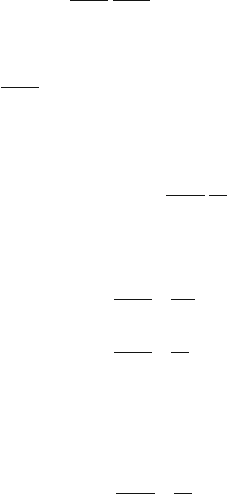
Chapter 11
Electrostatics
Abstract Chapter 11 deals with electrostatics comprising electric field and potential
for various configurations, electric dipole and quadrupole moments, Helmholtz
coils, electrostatic energy, Gauss’ law in integral and differential forms, capacitors,
parallel plates, cylindrical and spherical, various arrangements of capacitors.
11.1 Basic Concepts and Formulae
Coulomb’s law for charges q
1
and q
2
separated by r
F =
1
4πε
0
q
1
q
2
r
2
(Electric force) (11.1)
ε
0
= 8.85 ×10
−12
C
2
/N/m
2
1
4πε
0
= 9.0 ×10
9
Nm
2
/C
2
Electric field (E) for point charge q at distance r
E =
1
4πε
0
q
r
2
(11.2)
E for a sphere of radius R of uniform charge distribution
E =
1
4πε
0
·
qr
R
2
(r ≤ R)
=
1
4πε
0
·
q
r
2
(r ≥ R) (11.3)
E for hollow sphere of uniform charge distribution
E = 0 (r < R)
=
1
4πε
0
·
q
r
2
(r > R) (11.4)
459

460 11 Electrostatics
E for an infinite non-conducting sheet
E =
σ
2ε
0
(11.5)
E for an infinite conducting sheet
E =
σ
ε
0
(outside the sheet)
= 0 ( inside the sheet) (11.6)
Electric Potential
When a test charge q
0
is moved from point A (at potential V
A
) to the point B (at V
B
)
then the difference in electric potential is defined by the work done W
AB
by the
relation
V
B
− V
A
= W
AB
/q
0
(11.7)
If V
B
> V
A
, W
AB
is positive and if V
B
< V
A
, W
AB
is negative. By convention
V
A
= 0 when A is at infinite distance. Then the work required to move the test
charge q
0
from infinity to the field point is
V = W/q
0
(11.8)
Potential and field strength
V
B
− V
A
= W
AB
/q
0
= Ed (11.9)
where d is the distance of separation
Potential due to a point charge
V = Er (11.10)
V =
1
4πε
0
q
r
(11.11)
Potential due to a group of charges
V =
n
V
n
= V =
1
4πε
0
q
0
r
n
(11.12)
Potential due to uniform charge distribution in a non-conducting sphere

11.1 Basic Concepts and Formulae 461
V =
q
8πε
0
R
3 −
r
2
R
2
(r ≤ R) (11.13)
=
q
4πε
0
r
(r ≥ R) (11.14)
Calculation of E from V
E =−
dV
dr
(11.15)
Surface charge density
σ =
q
4πr
2
(11.16)
Electric potential energy (U)
U =
1
4πε
0
q
1
q
2
r
(11.17)
Capacitors
C =
q
V
(11.18)
where C is the capacitance.
Capacitance of a sphere
C =
q
V
= 4πε
0
R (11.19)
The parallel plate capacitor
C =
ε
0
KA
d
(11.20)
where A is the area of each plate, d is the distance of plates and K is the dielectric
constant.
Equilibrium of an Oil Drop
Let a charge −q be acquired by a small oil drop placed between two charged plates,
the upper one being positively charged. The drop is under the joint action of two
forces, the electric force acting upwards and the gravitational force acting down-
wards. If the drop is to remain suspended, then the condition for equilibrium is
qE = mg (11.21)
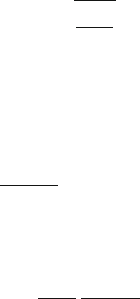
462 11 Electrostatics
Speed of a charged particle falling through a PD, V
v =
2qV
m
(11.22)
The electric dipole consists of two equal and opposite charges separated by
distance d.
The electric field on the perpendicular bisector of the dipole p = qd
E =
P
2πε
0
x
3
(x >> d) (11.23)
Potential due to a dipole
V =
1
4πε
0
P cos θ
r
2
(11.24)
where θ is the angle made by the vector r with the axis of the dipole, r being the
distance of the field point from the middle point of the dipole.
A Dipole in an Electric Field
Suppose a dipole is placed at a positive angle θ with the electric field E in the plane
of the page. Then the torque about the centre of the dipole is given by
τ = P × E (11.25)
its direction being perpendicular to the plane of the page and into the page.
The potential energy of the dipole is given by
U =−P · E (11.26)
Gauss’ Law
The flux (ϕ
E
) of the electric field (E)
ϕ
E
=
E · S (11.27)
where S is the surface area.
Gaussian surface is an imaginary closed surface. If infinitesimal areas are con-
sidered then the summation in (11.27) can be replaced by an integral over the sur-
face:
ϕ
E
=
E · ds (11.28)
Gauss’ law which relates the total flux ϕ
E
through this surface to the net charge
q enclosed by the surface can be stated as

11.1 Basic Concepts and Formulae 463
ε
0
ϕ
E
= q (11.29)
ε
0
E · ds = q (Gauss’ law) (11.30)
Capacitors in series
1
c
=
n
1
c
n
(11.31)
Capacitors in parallel
C =
n
C
n
(11.32)
Energy of a charged capacitor
W =
1
2
qV =
1
2
q
2
C
=
1
2
CV
2
(11.33)
Parallel Plate Capacitor with Dielectric
If a dielectric s lab of thickness t and dielectric constant K is introduced in a parallel
plate air capacitor, whose plates have area A and are separated by a distance d,the
capacitance becomes
C =
ε
0
A
d − t
1 −
1
K
(11.34)
If a metal of thickness t is introduced in the air capacitor, the effective distance
between the plates is reduced and the capacitance becomes
C =
ε
0
A
d − t
(11.35)
Energy Loss in the Combined System of Capacitors
If the positive end of a capacitor of capacitance C charged to potential difference
V is connected in parallel with the positive end of the capacitor of capacitance C
charged to potential difference V , then common potential difference will be
V =
C
1
V
1
+C
2
V
2
C
1
+C
2
(11.36)
and the energy loss will be
W =
1
2
C
1
C
2
C
1
+C
2
(V
1
− V
2
)
2
(11.37)

464 11 Electrostatics
If the positive end is joined to the negative end the common potential will be
V =
C
1
V
1
−C
2
V
2
C
1
+C
2
(11.38)
and the energy loss will be
W =
1
2
C
1
C
2
C
1
+C
2
(V
1
+ V
2
)
2
(11.39)
Dielectric Strength
Every dielectric material is characterized by dielectric strength which is the maxi-
mum value of the electric field that can be tolerated without breakdown resulting in
a conducting path between the plates of the capacitor.
Energy density (u) is defined as the electrostatic energy (U) per unit volume.
For a parallel plate capacitor of area A and plate separation d, the volume enclosed
between the plates is Ad.
u =
U
Ad
=
1
2
CV
2
Ad
(11.40)
But C = ε
0
A/d and V = Ed
u =
1
2
ε
0
E
2
(11.41)
Force of attraction between the capacitor plates is given by
F =−
1
2
ε
0
AV
2
d
2
(11.42)
Coalescing of Charged Drops
Let n identical droplets, each of charge q, coalesce to form a large drop of charge Q.
If the droplets are assumed to be incompressible, referring the parameters of the drop
primed and the droplets unprimed, the following relations will hold good:
Charge Q = q
= nq (11.43)
Surface charge density σ
= n
1/3
σ (11.44)
Capacitance C
= n
1/3
C (11.45)
Potential V
= n
2/3
V (11.46)
Energy stored W
= n
5/3
W (11.47)
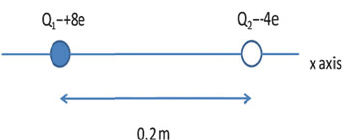
11.2 Problems 465
11.2 Problems
11.2.1 Electric Field and Potential
11.1
(a) Figure 11.1 shows two point clusters of charge situated in free space
placed on a line that is called the x-axis. The first, with a positive charge
of Q
1
=+8e, is at the origin. The second, with a negative charge of
Q
2
=−4e, is to the right at a distance equal to 0.2 m.
(i) What is the magnitude of the force between them?
(ii) Where would you expect to find the position of zero electric field:
to the left of Q
1
, between Q
1
and Q
2
or to the right of Q
2
? Briefly
explain your choice and then work out the exact position.
(b) The electron in a hydrogen atom orbits the proton at a radius of 5.3 ×
10
−11
m.
(i) What is the proton’s electric field strength at the position of the elec-
tron?
(ii) What is the magnitude of the electric force on the electron?
[University of Aberystwyth, Wales]
Fig. 11.1
11.2
(a) A tiny ball of mass 0.6 g carries a charge of magnitude 8 μC. It is sus-
pended by a thread in a downward electric field of intensity 300 N/C.
What is the tension in the thread if the charge on the ball is
(i) positive?
(ii) negative?
(b) A uniform electric field is in the negative x-direction. Points a and b are
on the x-axis, a at x = 2 m and b at x = 6m.
(i) Is the potential difference V
b
− V
a
positive or negative?
(ii) If the magnitude of V
b
− V
a
is 10
5
V, what is the magnitude E of the
electric field?
[University of Aberystwyth, Wales 2005]
11.3 Show that the electric potential a distance z above the centre of a horizontal
circular loop of radius R, which carries a uniform charge density per unit
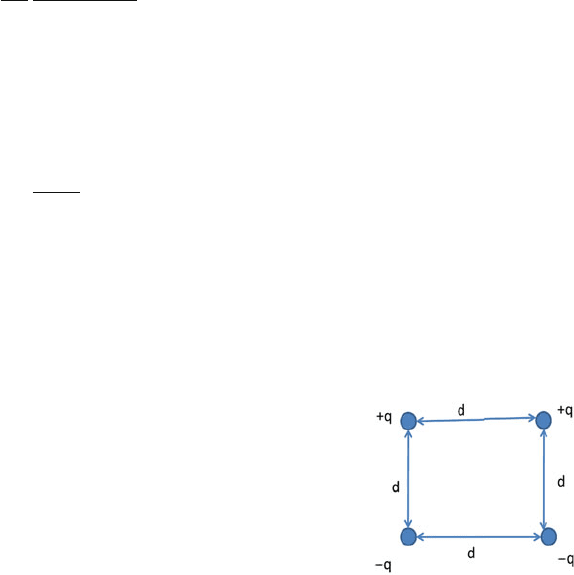
466 11 Electrostatics
length λ, is given by
V =
λR
2ε
0
1
(z
2
+ R
2
)
1/2
Obtain an expression for the electrostatic field strength as a function of z.
[University of Aberystwyth, Wales 2007]
11.4
(a) Starting from Coulomb’s law, show that the electric potential a distance r
from a point charge q is given by
V =
q
4πε
0
r
(b) Four point charges are assembled as shown in Fig. 11.2. Calculate the
potential energy of this configuration (you may assume that the charges
are isolated and in a perfect vacuum). Does the potential energy depend
upon the order in which the charges are assembled?
(c) Is the charge configuration in (b) stable?
Fig. 11.2
11.5 A spherical liquid drop has a diameter of 2 mm and is given a charge of 2 ×
10
−15
C.
(i) What is the potential at the surface of the drop?
(ii) If two s uch drops coalesce to form a single drop, what is the potential at
the surface of the drop so formed?
[Indian Institute of Technology 1973]
11.6 A pendulum bob of mass 80 mg carries a charge of 2 × 10
−8
Catrestina
horizontal uniform electric field of 20,000 V/m. Find the tension in the thread
of the pendulum and the angle it makes with the vertical.
[Indian Institute of Technology 1979]
11.7 An infinite number of charges, each equal to q, are placed along the x-axis at
x = 1, x = 2, x = 4, x = 8, etc. Find the potential and the electric field at the
point x = 0 due to the set of charges.
[Indian Institute of Technology 1974]
11.2 Problems 467
11.8 In prob. (11.7) what will be the potential and electric field in the above set-up
if the consecutive charges have opposite sign?
[Indian Institute of Technology 1974]
11.9 A thin fixed ring of radius 1 m has a positive charge 1 × 10
−5
C uniformly
distributed over it. A particle of mass 0.9 g and having negative charge of
1 × 10
−6
C is placed on the axis, at a distance of 1 cm from the centre of
the ring. Show that the motion of the negative charge is approximately simple
harmonic. Calculate the time period of oscillation.
[Indian Institute of Technology 1982]
11.10 Three charges, each of value q, are placed at the corners of an equilateral
triangle. A fourth charge Q is placed at the centre of the triangle.
(i) If Q =−q will the charges at the corners move towards the centre or
fly away from it?
(ii) For what value of Q will the charges remain stationary?
[Indian Institute of technology 1978]
11.11 Two identically charged spheres are suspended by strings of equal length.
The strings make an angle 30
◦
with each other. When suspended in a liquid of
density 0.8 g/cm
3
, the angle remains the same. What is the dielectric constant
of the liquid? The density of the material of the sphere is 1.6 g/cm
3
.
[Indian Institute of Technology 1976]
11.12 At the corner A of square ABCD of side 10 cm a charge 6×10
−8
C is placed.
Another charge of −3×10
−8
C is located at the centre of the square. Find the
work done in carrying a charge 5 × 10
−9
C from the corner C to the corner
B of the square.
[Indian Institute of Technology 1972]
11.13 A pith ball carrying a charge of 3 × 10
−10
C is suspended by an insulated
thread of length 50 cm. When a uniform electric field is applied in a horizon-
tal direction, the ball is found to deflect by 2 cm from the vertical. If the mass
of the ball is 0.5 g what is the magnitude and direction of the electric field?
[Indian Institute of Technology 1973]
11.14 A positively charged oil droplet remains in the electric field between two
horizontal plates, separated by a distance 1 cm. If the charge on the drop is
3.2 × 10
−19
C and the mass of the droplet is 10
−14
kg what is the potential
difference between the plates? Now if the polarity of the plates is reversed
what is the instantaneous acceleration of the droplet?
[Indian Institute of Technology 1974]
11.15 Suppose equal amount of charge of the same sign is placed on the earth
and the moon, what would be its magnitude if the gravitational attraction
between the two bodies may be nullified? Take mass of the earth and moon
to be 6 ×10
24
and 7.4 × 10
22
kg, respectively.
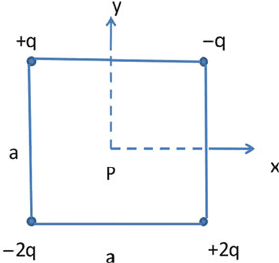
468 11 Electrostatics
11.16 A spark is produced between two insulated surfaces, maintained at a constant
difference of 5 × 10
6
V. If the energy output is 10
−5
J, calculate the charge
transferred. How many electrons have flowed?
[Indian Institute of Technology 1974]
11.17 A rod 25 cm long has a uniform linear charge density (charge per unit length)
λ = 200 μC/m. Calculate the electric field (in N/C) at 10 cm from one end
along the axis of the rod.
11.18 A disc of radius R is uniformly charged to Q and placed in the xy-plane with
its centre at the origin. Find the electric field along the z-axis.
11.19 Electronic charge e may be determined by Millikan’s oil drop method. Oil
drops of radius r acquire a terminal speed v
1
with downward electric field E
and a speed v
2
with the upward electric field. Derive an expression for e in
terms of E, v
1
, v
2
, r and η, the viscosity of oil in air.
11.20 A circular wire of radius r has a uniform linear charge density λ = λ
0
cos
2
θ.
Show that the total charge on the wire is πλ
0
r.
11.21 The distance between the electron and the proton in the hydrogen atom is
about 0.53 Å. By what factor is the electrical force stronger than the gravita-
tional force? Does the distance matter?
11.22 The combined charge on two small spheres is +15 μC. If each sphere is
repelled by the other by a force of 5.4 N when the spheres are 30 cm apart,
find the charges on the spheres.
11.23 Charges are placed at the four corners of a square of side a,asinFig.11.3.
Find the magnitude and direction of t he electric field at the centre of the
square.
Fig. 11.3
11.24 A thin, non-conducting rod of length L carries a total charge +Q spread
uniformly along it. Find the electric field at point p distant y from the axis of
the rod on the perpendicular bisector.
